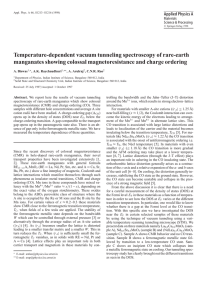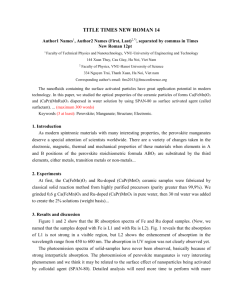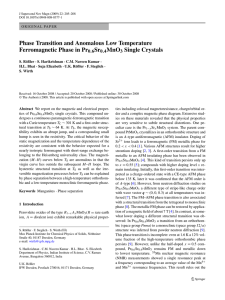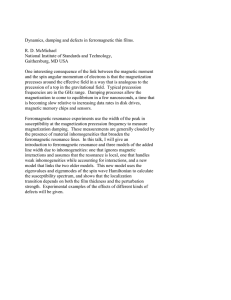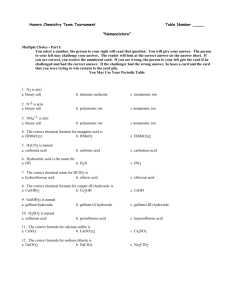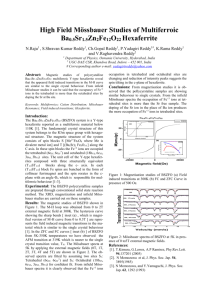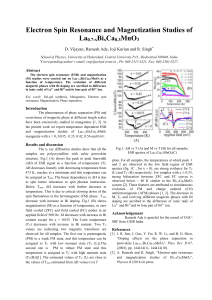Novel effects of size disorder on the electronic and
advertisement
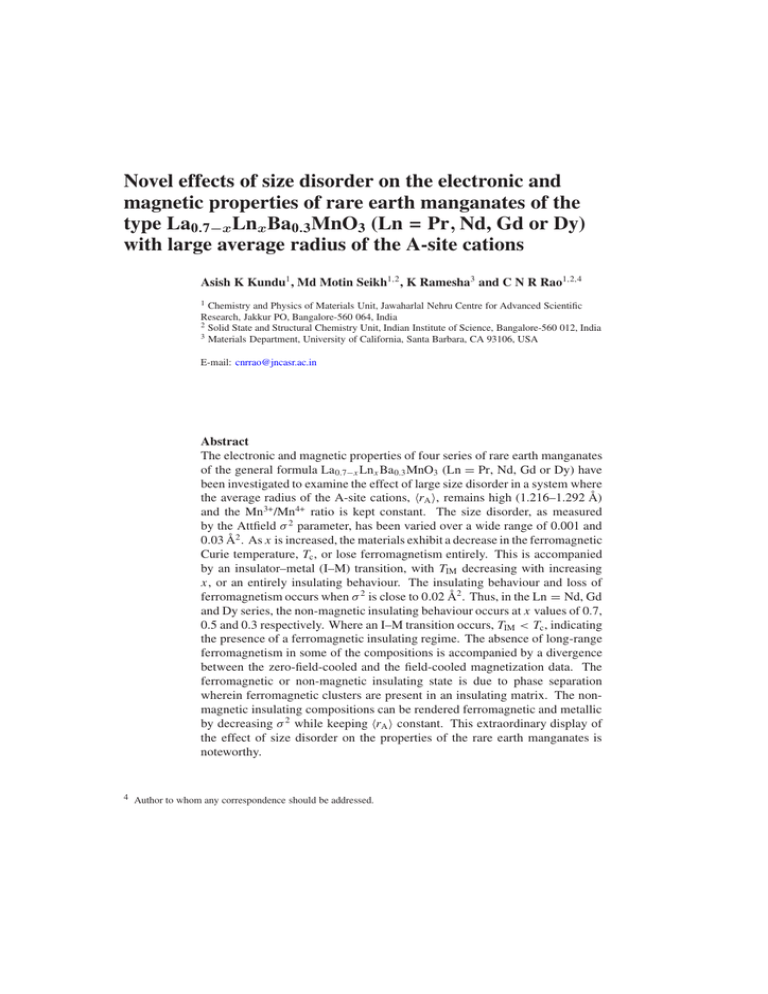
Novel effects of size disorder on the electronic and magnetic properties of rare earth manganates of the type La0.7−x Lnx Ba0.3 MnO3 (Ln = Pr, Nd, Gd or Dy) with large average radius of the A-site cations Asish K Kundu1 , Md Motin Seikh1,2 , K Ramesha3 and C N R Rao1,2,4 1 Chemistry and Physics of Materials Unit, Jawaharlal Nehru Centre for Advanced Scientific Research, Jakkur PO, Bangalore-560 064, India 2 Solid State and Structural Chemistry Unit, Indian Institute of Science, Bangalore-560 012, India 3 Materials Department, University of California, Santa Barbara, CA 93106, USA E-mail: cnrrao@jncasr.ac.in Abstract The electronic and magnetic properties of four series of rare earth manganates of the general formula La0.7−x Ln x Ba0.3 MnO3 (Ln = Pr, Nd, Gd or Dy) have been investigated to examine the effect of large size disorder in a system where the average radius of the A-site cations, rA , remains high (1.216–1.292 Å) and the Mn3+ /Mn4+ ratio is kept constant. The size disorder, as measured by the Attfield σ 2 parameter, has been varied over a wide range of 0.001 and 0.03 Å2 . As x is increased, the materials exhibit a decrease in the ferromagnetic Curie temperature, Tc , or lose ferromagnetism entirely. This is accompanied by an insulator–metal (I–M) transition, with TIM decreasing with increasing x, or an entirely insulating behaviour. The insulating behaviour and loss of ferromagnetism occurs when σ 2 is close to 0.02 Å2 . Thus, in the Ln = Nd, Gd and Dy series, the non-magnetic insulating behaviour occurs at x values of 0.7, 0.5 and 0.3 respectively. Where an I–M transition occurs, TIM < Tc , indicating the presence of a ferromagnetic insulating regime. The absence of long-range ferromagnetism in some of the compositions is accompanied by a divergence between the zero-field-cooled and the field-cooled magnetization data. The ferromagnetic or non-magnetic insulating state is due to phase separation wherein ferromagnetic clusters are present in an insulating matrix. The nonmagnetic insulating compositions can be rendered ferromagnetic and metallic by decreasing σ 2 while keeping rA constant. This extraordinary display of the effect of size disorder on the properties of the rare earth manganates is noteworthy. 4 Author to whom any correspondence should be addressed. 1. Introduction Rare-earth manganates of the type Ln1−x Ax MnO3 (Ln = rare earth, A = alkaline earth) exhibit many interesting properties such as colossal magnetoresistance,charge ordering, orbital ordering and electronic phase separation [1–5]. All these properties are highly sensitive to the average radius of the A-site cation, rA , as well as the size disorder arising from the mismatch between the A-site cations [4, 6, 7]. A detailed study of several compositions of the La0.7−x Lnx Ca0.3 MnO3 series of manganates has shown the occurrence of electronic phase separation above a critical composition x c [8–10]. In this series of manganates, rA decreases markedly with increase in x, accompanied by an increase in size disorder. Above x c , the materials become insulating and do not show ferromagnetism, the x c values corresponding to the critical rA value, rAc , of 1.18 Å. Electronic phase separation occurs in the region of rAc [8–10]. In order to fully appreciate the effect of the size mismatch between Asite cations, we considered it important to investigate a series of manganates, where the rA remains substantially large, well above rAc through the series, but the size disorder increases significantly. La0.7 Ba0.3 MnO3 , with rA of 1.292 Å, is a good ferromagnetic metal with a ferromagnetic transition temperature, Tc , of 340 K [11]. The Tc is, however, lower than the value expected on the basis of the large A-site cation radius, because of the mismatch the A-site cations [7, 12, 13]. Thus, the size variance, σ 2 , defined as between 2 2 2 σ = x i ri −rA , where x i is the fractional occupancy of A-site ions,ri is the corresponding ionic radius [12], is quite large, the value being 0.014 Å2 . Pr0.7 Ba0.3 MnO3 [14, 15], with a rA of 1.266 Å and σ 2 of 0.018 Å2 , shows a distinct ferromagnetic transition around 190 K due to long-range ferromagnetic ordering and an insulator–metal (I–M) transition at a lower temperature. The properties of Nd0.7 Ba0.3 MnO3 with an rA of 1.255 Å and σ 2 of 0.020 Å2 , however, appear to be quite different, with an unusual insulating behaviour [16]. We have investigated the effect of substitution of La in La0.7 Ba0.3 MnO3 by the smaller rare earth ions Pr, Nd, Gd and Dy, on the magnetic and electron transport properties, to understand the evolution of the insulating behaviour accompanying the disappearance of ferromagnetism, primarily arising from size disorder. It is to be noted that, in a given series of manganates, the size disorder increases considerably with x, although rA remains in the range 1.216–1.292 Å, and the carrier concentration or the Mn3+ /Mn4+ ratio is constant. In order to evaluate the effect of size disorder quantitatively, we have varied σ 2 in two series of manganates of the type Ln0.7−x Lnx A0.3−y Ay MnO3 , wherein rA is kept constant at 1.266 and 1.216 Å, corresponding to the rA of Pr0.7 Ba0.3 MnO3 and Gd0.7 Ba0.3 MnO3 respectively. 2. Experimental procedure Polycrystalline samples of La0.7−x Ln x Ba0.3 MnO3 (Ln = Pr, Nd, Gd and Dy) were prepared by the ceramic method. Stoichiometric mixtures of the respective rare earth oxides, alkaline earth carbonates and MnO2 were weighed in the desired proportions and milled for a few hours with propanol. The mixtures were dried, and calcined in air at 950 ◦ C, followed by heating at 1000 and 1100 ◦ C for 12 h each in air. The powders thus obtained were pelletized and the pellets sintered at 1400 ◦ C for 24 h in air. Two series of manganates of the general formula Ln0.7−x Lnx A0.3−y Ay MnO3 , with fixed rA values of 1.266 and 1.216 Å, were prepared by the same method. Composition analysis was carried out using energy dispersive x-ray analysis (EDAX) using a LEICA S440I scanning electron microscope fitted with a Si–Li detector. The oxygen stoichiometry was determined by iodometric titrations. The error in oxygen content was ±0.02. The oxygen stoichiometry in the La 0.7−x Lnx Ba 0.3 MnO3 and Ln0.7−x Lnx A0.3−y Ay MnO3 series studied by us was generally 2.97 ± 0.03. Table 1. Crystal structure and properties of La0.7−x Lnx Ba0.3 MnO3 (Ln = Pr, Nd, Gd or Dy). Lattice parameters (Å)a Composition rA (Å) σ2 (Å2 ) Space group a b √ c/ 2 Tc (K) TIM (K) x = 0.0 1.292 0.014 Pnma 5.534 5.529 5.529 340 — 5.514 5.523 5.510 5.500 5.495 5.527 5.519 5.503 5.507 5.505 320 285 235 210 190 — 270 210 175 150 5.513 5.506 5.497 5.524 5.507 5.498 250 190 150 240 160 — 5.524 5.516 5.511 5.491 5.487 5.471 5.525 5.517 5.511 5.497 5.488 5.477 280 210 150 — — — 275 190 120 — — — 5.515 5.508 5.501 5.496 5.525 5.511 5.497 5.496 270 190 — — 270 170 — — Ln = Pr x x x x x = 0.1 = 0.3 = 0.5 = 0.6 = 0.7 1.289 1.281 1.274 1.270 1.266 0.014 0.016 0.017 0.017 0.018 Pnma Pnma Pnma Pnma Pnma 5.529 5.527 5.517 5.520 5.512 Ln = Nd x = 0.3 x = 0.5 x = 0.7 1.276 1.266 1.255 0.017 0.018 0.020 Pnma Pnma Pnma 5.511 5.507 5.498 Ln = Gd x x x x x x = 0.1 = 0.2 = 0.3 = 0.5 = 0.6 = 0.7 1.281 1.270 1.259 1.238 1.227 1.216 0.016 0.019 0.021 0.025 0.026 0.027 Pnma Pnma Pnma Pnma Pnma Pnma 5.527 5.527 5.521 5.496 5.496 5.479 Ln = Dy x x x x = 0.1 = 0.2 = 0.3 = 0.4 a Uncertainty is approximately ±0.004. 1.279 1.266 1.252 1.239 0.017 0.020 0.023 0.026 Pnma Pnma Pnma Pnma 5.530 5.521 5.510 5.507 The phase purity of the manganates was established by recording the x-ray diffraction patterns in the 2θ range 10◦ –80◦ with a Seiferts 3000 TT diffractometer using Cu Kα radiation. Electrical resistivity (ρ) measurements were carried out from 320 to 20 K by the four-probe method. Magnetization (M) measurements were made with a vibrating sample magnetometer (VSM) (Lakeshore 7300) and with a Quantum Design MPMS 5XL magnetometer. In the VSM and MPMS 5XL measurements the data were collected in the 300–50 and 350–10 K ranges, respectively. The temperature dependence of the zero-field-cooled (ZFC), field-cooled (FC) and the frequency dependence AC susceptibility measurements were recorded in the MPMS 5XL magnetometer. For the ZFC measurement the sample was cooled down from 350 to 10 K in zero-field, and for the FC measurement the sample was cooled to 10 K in an applied field of 500 Oe. The data were all recorded during reheating the sample. 3. Results and discussion All the manganate compositions of the formula La0.7−x Ln x Ba0.3 MnO3 (Ln = Pr, Nd, Gd and Dy) could be indexed on an orthorhombic structure with the Pnma space group. We have listed the lattice parameters of the various compositions in table 1 along with the values of rA and the size variance σ 2 . The lattice parameters as well as the volume of the unit cell (a) (b) Figure 1. Temperature variation of (a) the magnetization, M, (H = 500 Oe) and (b) the electrical resistivity, ρ, of La0.7−x Pr x Ba0.3 MnO3 . vary linearly with rA , as expected. In figure 1, we show the magnetization and resistivity data of the La0.7−x Pr x Ba0.3 MnO3 series of manganates. The Tc value decreases progressively with increasing x, reaching a value of 190 K in Pr 0.7 Ba0.3 MnO3 . The value of the saturation magnetization decreases only slightly with the increase in x (35–29 emu g−1 at 60 K in the x = 0.0–0.7 range). The material is metallic at room temperature up to x = 0.3 and exhibits a broad I–M transition when x 0.3, the transition temperature, TIM , decreasing with increasing x. Pr0.7 Ba0.3 MnO3 itself shows an I–M transition around 150 K (TIM ) which is lower than the Tc value. This value of TIM is somewhat higher than that reported by Heilman et al [14]. It is interesting that, as x approaches 0.7, the difference between Tc and TIM increases, with the latter becoming considerably lower than Tc . Pr0.7 Ba0.3 MnO3 is, therefore, a ferromagnetic insulator in the regime between Tc and TIM (190–150 K). The magnetization and resistivity data of La0.7−x Nd x Ba0.3 MnO3 are shown in figure 2. Here again, the Tc value decreases with increasing x, and there is a marked decrease in the value of the saturation magnetization as well. There is a sharp increase in magnetization with an apparent Tc of ∼150 K in Nd0.7 Ba0.3 MnO3 . But the saturation moment is small, suggesting there may be no long-range ferromagnetic ordering in the material. Thus, the saturation magnetization is 30 emu g−1 at x = 0.3 and Nd0.7 Ba0.3 MnO3 (x = 0.7) does not exhibit clear saturation down to low temperatures. The highest value of magnetization obtained for Nd0.7 Ba0.3 MnO3 is 18 emu g−1 at 60 K compared to 35 emu g−1 in La0.7 Ba0.3 MnO3 . (a) (b) 20 20 15 15 10 10 5 0 5 (a) (c) 0 8 20 6 15 4 10 M(emu/g) M(emu/g) Figure 2. Temperature variation of (a) the magnetization, M, (H = 500 Oe) and (b) the electrical resistivity, ρ, of La0.7−x Ndx Ba0.3 MnO3 . The arrow mark is explained in text. 5 2 (b) (d) 0 0 0 50 100 150 200 0 50 100 150 200 T(K) Figure 3. Temperature variation of the magnetization, M, of (a) Nd0.7 Ba0.3 MnO3 (b) Gd0.7 Ba0.3 MnO3 (c) La0.2 Gd0.5 Ba0.3 MnO3 and (d) La0.4 Dy0.3 Ba0.3 MnO3 (at H = 500 Oe). The solid symbols represent FC and open symbols represent ZFC data, respectively. (a) (b) Figure 4. Temperature variation of (a) the magnetization, M, (H = 500 Oe) and (b) the electrical resistivity, ρ, of La0.7−x Gdx Ba0.3 MnO3 . The saturation magnetic moments in Nd0.7 Ba0.3 MnO3 and La0.7 Ba0.3 MnO3 are 0.8 and 1.5 µB respectively, while that in Pr0.7 Ba0.3 MnO3 is 1.2 µB (at H = 500 Oe). Accordingly, the ZFC and FC data show considerable divergence below Tc (figure 3(a)), unlike in Pr0.7 Ba0.3 MnO3 . The resistivity behaviour of La0.7−x Nd x Ba0.3 MnO3 is quite different from that of La0.7−x Pr x Ba0.3 MnO3 . The La0.7−x Nd x Ba0.3 MnO3 compositions show a broad I–M transition when x = 0.3 and 0.5, but the 0.7 composition is an insulator with high resistivity. The resistivity behaviour of Nd0.7 Ba0.3 MnO3 found by us differs from the earlier report [16] to some extent. We do not find a distinct I–M transition in this material nor two resistivity peaks around TIM . We barely see a shoulder around Tc as shown by the arrow in figure 2. Since Nd0.7 Ba0.3 MnO3 does not show long-range ferromagnetic ordering, it would appear that the material contains ferromagnetic clusters in the insulating matrix. The double peaks in resistivity data reported earlier [16] or the shoulder near Tc found by us also suggest such phase separation. Ferromagnetic clusters in an insulating matrix would also be present in other compositions (0.0 < x < 0.7) where Tc > TIM . In the La0.7−x Gd x Ba0.3 MnO3 series, progressive substitution of La by Gd causes the ferromagnetic features to disappear entirely when x 0.5 (figure 4(a)). Even when x = 0.3, the Tc is only 155 K and the saturation magnetization is 20 emu g−1 at 60 K. (a) (b) Figure 5. Temperature variation of (a) the magnetization, M, (H = 500 Oe) and (b) the electrical resistivity, ρ, of La0.7−x Dyx Ba0.3 MnO3 . The x 0.5 compositions exhibit divergence between the ZFC and FC magnetization data (see figures 3(b) and (c)), indicating the absence of long-range ferromagnetic ordering. AC susceptibility measurements reveal a weakly frequency-dependent peak at 50 and 40 K respectively in the x = 0.5 and 0.7 compositions. These compositions also fail to show the I–M transitions in the resistivity data, whereas the samples with x < 0.5 show distinct I–M transitions. The compositions with x > 0.5 are insulating just as Nd0.7 Ba0.3 MnO3 and the resistivity of Gd0.7 Ba0.3 MnO3 is higher than that of Nd0.7 Ba0.3 MnO3 (figure 4(b)). In the La0.7−x Dyx Ba0.3 MnO3 series, ferromagnetism does not occur for x > 0.2 (figure 5(a)). The x = 0.2 composition shows an apparent Tc of 180 K, but the saturation magnetization is very low (18 emu g−1 ). The x = 0.2 composition shows the I–M transition, but all the compositions with x > 0.2 are insulating, the resistivity being higher than that of the corresponding Gd and Nd substituted manganates. The ZFC and FC data of the x = 0.3 composition show divergence (figure 3(d)), indicating the absence of long-range ferromagnetic ordering. In both the La0.7−x Gd x Ba0.3 MnO3 and La0.7−x Dyx Ba0.3 MnO3 series of manganates, ferromagnetism disappears as x increases, accompanied by an insulating behaviour. The apparent ferromagnetic transitions with a low saturation magnetization observed for x = 0.3 and 0.2 at 150 and 180 K respectively in the Gd and Dy derivatives, and associated with TIM values lower than Tc , pointing to the presence of a ferromagnetic insulating state. It is likely (a) Å Å (b) Figure 6. Temperature variation of (a) the magnetization, M, (H = 500 Oe) and (b) the electrical resistivity, ρ, of Ln0.7−x Lnx A0.3−y Ay MnO3 with a fixed rA value of 1.266 Å. that, in all the compositions where the ferromagnetic insulating state occurs, there is phase separation wherein ferromagnetic clusters are present in an insulating matrix. It is interesting that the difference between Tc and TIM manifests itself only when σ 2 is considerably large. In the four series of La0.7−x Ln x Ba0.3 MnO3 studied by us, the difference between Tc and TIM starts emerging when the σ 2 = 0.016 Å2 , although the rA is relatively large, being around 1.28 Å. Clearly the size disorder plays a crucial role in determining the properties of these manganates. In order to investigate the effect of size disorder quantitatively, we have examined the compositions with constant rA values corresponding to Pr0.7Ba0.3 MnO3 and Gd0.7 Ba0.3 MnO3 respectively, and varied the σ 2 . In table 2, we list the structural parameters of two series of manganates. The magnetization and resistivity data of the compositions with rA = 1.266 Å are shown in figure 6. We see that Tc increases with decreasing σ 2 and the material becomes metallic at the lowest value of σ 2 = 0.008 Å2 , while I–M transitions occur in the σ 2 range 0.02–0.01 Å2 . This is indeed a nice result in that a system normally showing an I– M transition becomes metallic as the size disorder is decreased. The effect of size disorder is seen more vividly when the rA value is 1.216 Å, corresponding to Gd0.7 Ba0.3 MnO3 , a non-magnetic insulating material. However, when the size disorder is decreased, the material becomes ferromagnetic, with Tc going up to ∼300 K at the lowest value of σ 2 (figure 7(a)). As σ 2 decreases, the insulating behaviour also gives way to metallic behaviour. The Tc (a) Å σ2(Å2) (b) T(K) Figure 7. Temperature variation of (a) the magnetization, M, (H = 500 Oe) and (b) the electrical resistivity, ρ, of Ln0.7−x Lnx A0.3−y Ay MnO3 with a fixed rA value of 1.216 Å. Table 2. Crystal structure of Ln0.7−x Lnx A0.3−y Ay MnO3 with fixed rA . Composition σ2 (Å2 ) Lattice parameters (Å) Space group a b √ c/ 2 V (Å3 ) 5.496 5.508 5.495 5.508 5.596 5.501 5.505 5.511 236 237 236 237 5.468 5.464 5.474 5.473 5.472 5.471 5.476 5.469 5.474 5.469 5.473 5.477 232 232 233 233 233 233 rA = 1.266 Å La0.7 Ba0.14 Sr0.16 MnO3 La0.7 Ba0.21 Ca0.09 MnO3 Pr0.7 Ba0.3 MnO3 La0.5 Dy0.2 Ba0.3 MnO3 0.008 0.011 0.018 0.021 Pnma Pnma Pnma Pnma 5.520 5.537 5.512 5.521 rA = 1.216 Å La0.7 Sr0.08 Ca0.22 MnO3 Nd0.7 Ba0.06 Sr0.24 MnO3 Pr0.7 Ba0.125 Ca0.125 MnO3 Nd0.7 Ba0.165 Ca0.135 MnO3 Sm0.7 Ba0.24 Ca0.06 MnO3 Gd0.7 Ba0.3 MnO3 0.001 0.008 0.009 0.013 0.021 0.028 Pnma Pnma Pnma Pnma Pnma Pnma 5.467 5.474 5.485 5.490 5.483 5.479 values (in figures 6(a) and 7(a)) vary linearly with σ 2 with the slopes of 10 235 ± 2191 and 17 068 ±3260 K Å−2 for rA of 1.266 Å and rA of 1.216 Å, respectively. The corresponding values of intercepts, Tc0 , are 374 ± 5 and 305 ± 3 K, respectively. These values are comparable to those reported in the literature for other series of manganates [10, 17]. 4. Conclusions The present study on the electronic and magnetic properties of the four series of La0.7−x Lnx Ba0.3 MnO3 (Ln = Pr, Nd, Gd and Dy) manganates, wherein the average radius of the A-site cation generally remains large (1.216–1.292 Å), but the size disorder is also considerable, has revealed certain interesting aspects. Since the band narrowing due to small rA is entirely avoided, the predominant effect is due to size disorder. It is interesting that these materials show a progressive decrease in the ferromagnetic TC , eventually giving rise to a non-magnetic insulating behaviour. Accordingly, with increasing x or σ 2 , the material exhibits a ferromagnetic insulating phase due to the presence of ferromagnetic clusters in the insulating matrix. At large x or σ 2 , where some of the compositions lose ferromagnetism and become insulating, there is evidence for clusters with short-range ferromagnetic interaction. In the insulating regime caused by size disorder, there is clearly phase separation due to the presence of ferromagnetic clusters in an insulating matrix. The phase separation is minimized or eliminated by decreasing σ 2 , as evidenced from the change of the non-magnetic insulating phase to a ferromagnetic metallic state. Acknowledgments The authors would like to thank BRNS (DAE), India, for support of this research. AKK thanks the University Grants Commission and MMS thanks CSIR, India, for a research fellowship award. References [1] Rao C N R and Raveau B (ed) 1998 Colossal Magnetoresistance, Charge Ordering, and Related Properties of Manganese Oxides (Singapore: World Scientific) [2] Tokura Y (ed) 1999 Colossal Magnetoresistance Oxides (London: Gordon and Breach) [3] Ramirez A P 1997 J. Phys.: Condens. Matter 9 8171 [4] Rao C N R 2000 J. Phys. Chem. B 104 5877 [5] Dagotto E (ed) 2003 Nano Scale Phase Separation and Colossal Magnetoresistance (Berlin: Sringer) [6] Rao C N R and Vanitha P V 2002 Curr. Opin. Solid State Mater. Sci. 6 97 [7] Rogriguez-Martinez L M and Attfield J P 2000 Phys. Rev. B 63 024424 [8] Uehara M, Mori S, Chen C H and Cheong S W 1999 Nature 399 560 [9] Balagurov A M, Pomjakushin V Yu, Sheptyakov D V, Aksenov V L, Fischer P, Keller L, Gorbenko O Yu, Kaul A R and Babushkina N A 2001 Phys. Rev. B 64 024420 [10] Sudheendra L and Rao C N R 2003 J. Phys.: Condens. Matter 15 3029 and references therein [11] Ju H L, Gopalakrishnan J, Peng J L, Li Qi, Xiong G C, Venkatesan T and Greene R L 1995 Phys. Rev. B 51 6143 [12] Rogriguez-Martinez L M and Attfield J P 1996 Phys. Rev. B 54 R15622 [13] Mahesh R, Mahendiran R, Raychaudhuri A K and Rao C N R 1995 J. Solid State Chem. 120 204 [14] Heilman A K, Xue Y Y, Lorenz B, Campbell B J, Cmaidalka J, Meng R L, Yang Y S and Chu C W 2002 Phys. Rev. B 65 214423 [15] Ellouze M, Boujelben W, Cheikhrouhou A, Fuess H and Madar R 2002 Solid State Commun. 124 125 [16] Maignan A, Martin C, Hervieu M, Raveau B and Hejtmanek J 1998 Solid State Commun. 107 363 [17] Damay F, Martin C, Maignan A and Raveau B 1997 J. Appl. Phys. 82 6181
